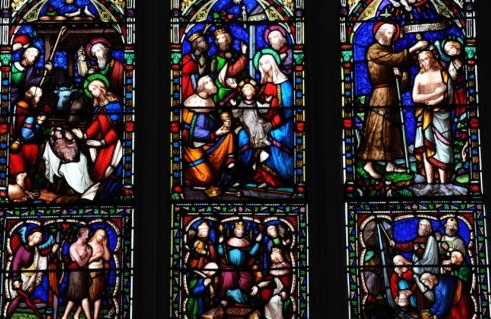Abridged from last week's Yorkshire Post
Exploring the church heritage on our doorstep
by Chris Bond
 A group of teenagers lounge around listlessly, laughing and smoking and enjoying the warm afternoon sunshine.They probably have no idea that the slabs of polished stone lying just a few feet away on the railway embankment are in fact gravestones. It’s just one of several nuggets of information gleaned while talking to architectural historian Dr Christopher Webster about the history of Leeds Minster across the road.
A group of teenagers lounge around listlessly, laughing and smoking and enjoying the warm afternoon sunshine.They probably have no idea that the slabs of polished stone lying just a few feet away on the railway embankment are in fact gravestones. It’s just one of several nuggets of information gleaned while talking to architectural historian Dr Christopher Webster about the history of Leeds Minster across the road.
Last week, Dr Webster gave a talk entitled, "The Noblest Construction in Modern Times; Building Leeds Minster". It was part of the annual Church Explorers festival, set up by the Jorvik Group, which aims to retell forgotten stories from Yorkshire’s neighbourhood churches and encourage more people to visit what organisers are calling Britain’s most undervalued heritage.
 Dr Chris Tuckley, from the York Archaeological Trust which oversees the programme, points out that many people who walk past churches are unaware of their history. “Our churches are like giant storybooks, full of amazing stories. If they were manuscripts, they would be under lock and key in national museums, the envy of the world, and yet we pass by them in our neighbourhoods, unaware of their secrets and their importance.”
Dr Chris Tuckley, from the York Archaeological Trust which oversees the programme, points out that many people who walk past churches are unaware of their history. “Our churches are like giant storybooks, full of amazing stories. If they were manuscripts, they would be under lock and key in national museums, the envy of the world, and yet we pass by them in our neighbourhoods, unaware of their secrets and their importance.”
Much of this was down to the influence of Dr Walter Hook who became the church’s vicar when he arrived in the spring of 1837. Hook was a leading light in the Church of England during the mid 19th Century. “He was energetic and charismatic and because he was an important figure nationally it meant that all eyes were on Leeds,” says Dr Webster.
Hook quickly decided the old church, which was in a state of disrepair, needed renovating but after six months this evolved into a completely new building. The old Medieval church was demolished the following year and in 1841 the new parish church was built.
The initial costs were expected to come in at around £2,500, this quickly doubled and then spiralled upwards with the final bill amounting to just shy of £30,000 – the equivalent of many millions of pounds in today’s money.
“If you were wealthy the most fashionable thing you could do was give money for a new church,” says Dr Webster. All the money came from churchgoers of all walks of life – including penny subscriptions from widows as well as larger donations from wealthy mill owners. “One of the windows was referred to as ‘the penny window’ because the stained glass was paid for by hundreds of contributions of pennies.”
 Richard Butterfield, director of operations and development at Leeds Minster, says the Church Explorers programme is a way of encouraging people to take a closer look at their local churches: “Leeds Minster is the fifth church that has existed on this site, and inside there's an Anglo-Saxon cross dating back more than a thousand years. But people often aren’t aware of this history.
Richard Butterfield, director of operations and development at Leeds Minster, says the Church Explorers programme is a way of encouraging people to take a closer look at their local churches: “Leeds Minster is the fifth church that has existed on this site, and inside there's an Anglo-Saxon cross dating back more than a thousand years. But people often aren’t aware of this history.
“The Minster is open seven days a week and we put on various events, talks and concerts, that reveal more of that history and heritage to people.
“We’ve just had 50 Chinese visitors who wanted to have a look round. And we get people who are Leeds born and bred who'd never been in here and when they come in they’re stunned and delighted by what they find.”
The church also boasts a series of mosaics by Salviati, the acclaimed Venetian family, whose workshop can still be found along the Grand Canal in Venice. “As 19th Century mosaics go Salviati was good as they get,” says Dr Webster. “Many of our churches are magnificent monuments to an industrial society and Leeds Minster is every bit as important to the city’s heritage as the town hall,” he says.
Rediscovering church history
Forgotten stories from 19 Yorkshire churches are being retold during this summer's Church Explorers programme (churchexplorers.co.uk). Among those taking part is St Olave’s on Marygate in York and Selby Abbey, which was the first monastery to be founded in the north of England after the Norman Conquest, and contains medieval features that have survived intact despite the Dissolution in 1539.